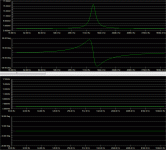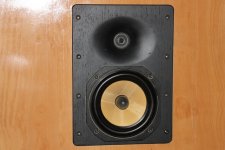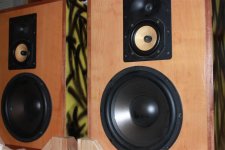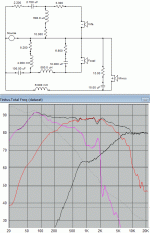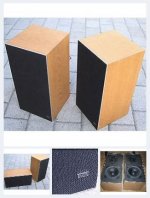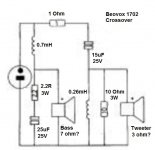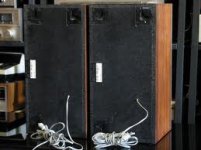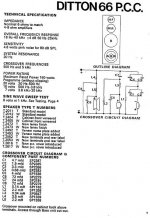tinitus said:apart from impedance, its important to note that a zobel also affects phase
Yes and speaking of which, a few things that may cause the ideal RLC correction to fail are: The model is idealistic and component tolerances and our calculations may cause this correction to be all but complete. Driver non-linearities might cause dynamic imbalances, and flawed components might possibly bring their own signature. Only this last one however is a potential reason not to do this (IMO).
Phase is of course an indicator of reactance. This plot shows nothing that hasn't already been shown. (Top to bottom...magnitude/phase - without/with correction)
Attachments
Last edited:
sounds like quite a lot can go wrong, with those 'variables' you mention
for one, Fs may change in time, no ?
phase still turns through out the whole system(speaker), and always will, no ?
and not to forget that relative phase varies even on each driver cone, in its own passband(and stopband)
I suppose thats not easy to simulate, is it ?
I fear there is still a lot that could tilt even a perfect model
and my personal experience is that when it tilts, it is very audible
for one, Fs may change in time, no ?
phase still turns through out the whole system(speaker), and always will, no ?
and not to forget that relative phase varies even on each driver cone, in its own passband(and stopband)
I suppose thats not easy to simulate, is it ?
I fear there is still a lot that could tilt even a perfect model
and my personal experience is that when it tilts, it is very audible
Nice. Looks like a notch filter really works well for a tweeter. Awkwardly high capacitance value though, good 15uF is pricey.
I've been playing with a notch filter calculator:
Series Notch Fliter Designer / Calculator
Zobel calculator for completeness:
Impedance Equalization (L-Pad) Circuit Designer / Calculator
I think the above diagram makes it evident you use a gentler notch filter with a low Q driver. You'd need Qms and Qes for exactness, which you don't often get specified. Apparently ferrofluid tweeters are altogether more flat in impedance, and notch and Zobel less required which might explain my own tweeter woes since the ferro went AWOL.
We really ought to get back to tinitus' latest crossover now.
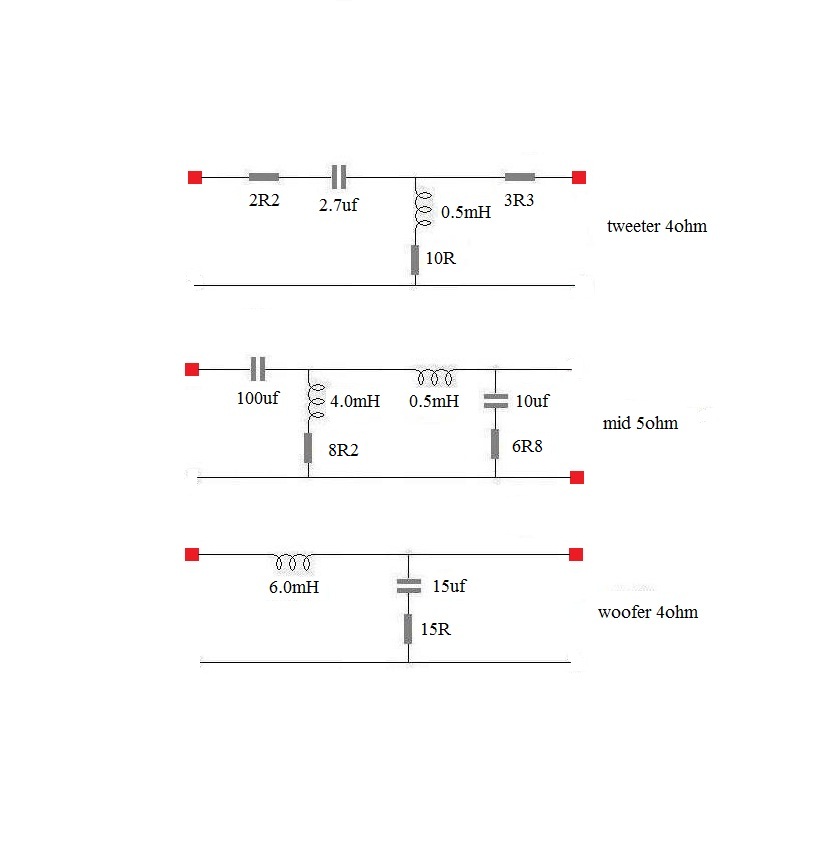
I've been playing with a notch filter calculator:
Series Notch Fliter Designer / Calculator
Zobel calculator for completeness:
Impedance Equalization (L-Pad) Circuit Designer / Calculator
An externally hosted image should be here but it was not working when we last tested it.
I think the above diagram makes it evident you use a gentler notch filter with a low Q driver. You'd need Qms and Qes for exactness, which you don't often get specified. Apparently ferrofluid tweeters are altogether more flat in impedance, and notch and Zobel less required which might explain my own tweeter woes since the ferro went AWOL.
We really ought to get back to tinitus' latest crossover now.

Last edited:
We really ought to get back to tinitus' latest crossover now.
hmm,its just an update I do, occationally
and there be more of them
but wont change much
its just to 'row the boat'
Im happy with whatever comes up here, about classic monitor designs
besides, its not really my thread, I only kept it going
but you are welcome to try a simulation with my filter
sounds like quite a lot can go wrong, with those 'variables' you mention
for one, Fs may change in time, no ?
Good point. I only use measured data on any serious design, and I'll typically refresh it 'from time to time'.
Awkwardly high capacitance value though, good 15uF is pricey.
They weren't 'real' values, not that that is the point though.
I don't mind using electrolytic capacitors in this position. If the capacitors have series resistance, or series inductance, well there's actual resistance and actual inductance in this leg of the circuit regardless and it all goes to a good cause. Besides, the response has usually been brought down a bit by this range anyway.
you are welcome to try a simulation with my filter
Do you have impedance data with phase? or at least other good info about the drivers?
http://www.mivoc.com/downloads/de/mivoc/PDF/AW3000-Datenblatt_WEB.pdf
http://www.tymphany.com/files/XT19TD00-04 Rev1_0.pdf
midrange is Focal 5K013L
I have had specs, but cant find much now
never seen a response
and uncertain what the tweeter horn does(?)
http://www.tymphany.com/files/XT19TD00-04 Rev1_0.pdf
midrange is Focal 5K013L
I have had specs, but cant find much now
never seen a response
and uncertain what the tweeter horn does(?)
Attachments
I've come up with a draft plot. There are some limitations. They are as follows....
I got some response files from Roman Bednarek. They are for the XT19, and the Focal 5W4211. I think this mid is very similar to yours, different cone material though. I also am not sure of the baffle conditions of the response measurements. I couldn't get an impedance plot for the woofer so I simulated it, then modified an impedance plot for another 12" woofer I had. The response is from Mivoc's site. The box volume wasn't included but that's easy to add in by sight. The baffle wasn't included but it will be obvious anyway, and no acoustic phase has been allowed for.
The response looks good, considering. Flat where it's important, baffle looks compensated for, and you seem to have a top end roll-off very similar to the roll-off I go for myself.
Would you like the .swd files?
I got some response files from Roman Bednarek. They are for the XT19, and the Focal 5W4211. I think this mid is very similar to yours, different cone material though. I also am not sure of the baffle conditions of the response measurements. I couldn't get an impedance plot for the woofer so I simulated it, then modified an impedance plot for another 12" woofer I had. The response is from Mivoc's site. The box volume wasn't included but that's easy to add in by sight. The baffle wasn't included but it will be obvious anyway, and no acoustic phase has been allowed for.
The response looks good, considering. Flat where it's important, baffle looks compensated for, and you seem to have a top end roll-off very similar to the roll-off I go for myself.
Would you like the .swd files?
Attachments
Very interesting. Thoughts. The Focus 5" is almost a car bass/mid speaker...good from 100Hz to 5kHz. The tweeter is very extended in FR to 30kHz. The Mivoc bass has about 3dB of lift from 60 to 300Hz which makes the efficiency a bit vague but relatively high here, good to 800Hz.
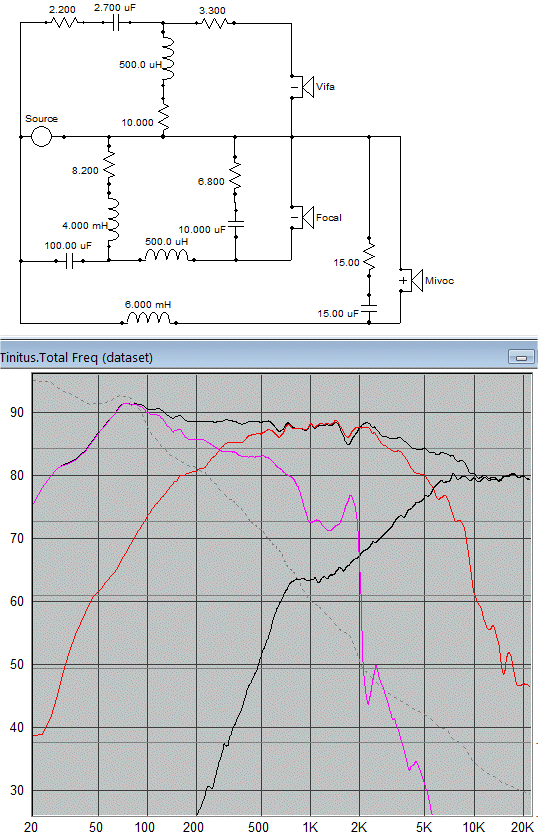
I make that Mivoc 12" bass: 90dB, Vas 97l, Qts 0.31, Fs 27Hz, 4 ohm, 3 ohm Re. Rough good enclosure size: 40-55l.
Focus 5" (albeit from different unit): 87dB, Vas 13.7l, Qts 0.28, Fs 46.5Hz, approx 4 ohm. Rough good enclosure size: 8l.
Peerless/Vifa XT19 vented tweeter: 87dB without waveguide, Le 0.01mH, Fs 780Hz, 3.3 ohm Re. Qms 3.1, Qes 0.83, Qts 0.65.
FWIW, quite a high Q on the bare tweeter without waveguide. Possible to overdrive it quite easily without high order filter or compensation, I'd think. Not sure if it has ferrofluid. Looks like not, but it's a very nice looking tweeter.

I make that Mivoc 12" bass: 90dB, Vas 97l, Qts 0.31, Fs 27Hz, 4 ohm, 3 ohm Re. Rough good enclosure size: 40-55l.
Focus 5" (albeit from different unit): 87dB, Vas 13.7l, Qts 0.28, Fs 46.5Hz, approx 4 ohm. Rough good enclosure size: 8l.
Peerless/Vifa XT19 vented tweeter: 87dB without waveguide, Le 0.01mH, Fs 780Hz, 3.3 ohm Re. Qms 3.1, Qes 0.83, Qts 0.65.
FWIW, quite a high Q on the bare tweeter without waveguide. Possible to overdrive it quite easily without high order filter or compensation, I'd think. Not sure if it has ferrofluid. Looks like not, but it's a very nice looking tweeter.
Last edited:
This Troels Gravesen update of a SEAS 503 Classic 3-way kit was interesting, tinitus:
SEAS Kit 503
Troels redesigns the midrange to 2nd order on each slope, and fits a 3rd order butterworth to the tweeter. I think the 3-way crossovers he invariably uses on tweeters improves power handling by getting the tweeter Fs well down in frequency response. The 8.2R series resistor with the midrange crossover shunt capacitor is presumably to stop the shunt L and C of the high stop and Mid pass interacting. Any series resonance interaction is presumably largely damped by the loudspeaker resistance.
He has a nice way of mounting crossovers on tag strip on a piece of ply too.
SEAS Kit 503
Troels redesigns the midrange to 2nd order on each slope, and fits a 3rd order butterworth to the tweeter. I think the 3-way crossovers he invariably uses on tweeters improves power handling by getting the tweeter Fs well down in frequency response. The 8.2R series resistor with the midrange crossover shunt capacitor is presumably to stop the shunt L and C of the high stop and Mid pass interacting. Any series resonance interaction is presumably largely damped by the loudspeaker resistance.
He has a nice way of mounting crossovers on tag strip on a piece of ply too.
This Troels Gravesen update of a SEAS 503 Classic 3-way kit was interesting
yes, Troels is indeed a brave man
I knew he had a 3way monitor, but havent seen that restoring project
when you mention his 3rd order on tweeter, notice that its acoustic slope matches that of the midrange
Troels redesigns the midrange to 2nd order on each slope, and fits a 3rd order butterworth to the tweeter.
Getting this thread back on topic vaguely...Classic Monitors...
Nothing nicer to look at than Jacob Jensen's classic Bang and Olufsen setups. Especially in rosewood. The Steve Jobs of HiFi, IMO!
Most of that stuff found its way into the Museum of Modern Art in New York. I had the matching Beovox 2702 small speakers which had 6" woofer and 2" tweeter. Designed to work with the main 3 way 5700 models in 4 speaker Ambiophonics. Very good dispersion and some neat touches like rear wall mounting plates. Lovely to look at, of course. The foam surrounds do tend to rot though. I have included the crossover, which is standard 2nd. order stuff, but interesting for the bigger than expected bass capacitor and resistor which probably tweaks the phase a bit. A little attenuation on the tweeter which helps damp Fs and a crossover of ca. 2.2 KHz, I reckon.
Nothing nicer to look at than Jacob Jensen's classic Bang and Olufsen setups. Especially in rosewood. The Steve Jobs of HiFi, IMO!
An externally hosted image should be here but it was not working when we last tested it.
Most of that stuff found its way into the Museum of Modern Art in New York. I had the matching Beovox 2702 small speakers which had 6" woofer and 2" tweeter. Designed to work with the main 3 way 5700 models in 4 speaker Ambiophonics. Very good dispersion and some neat touches like rear wall mounting plates. Lovely to look at, of course. The foam surrounds do tend to rot though. I have included the crossover, which is standard 2nd. order stuff, but interesting for the bigger than expected bass capacitor and resistor which probably tweaks the phase a bit. A little attenuation on the tweeter which helps damp Fs and a crossover of ca. 2.2 KHz, I reckon.
Attachments
The very keen eyed will notice the nice 2" dome treble in the Bang & Olufsen loudspeakers. It was made by Celestion, who made everybody's 70s party speaker, The Celestion Ditton 66. Man these impressively huge things could ROCK! 
There's a secret lurking in that unique Celestion 2" dome midrange if you think that 5KHz sound has a wavelength around 3". These babies were close to linear phase, because the midrange is almost the same size and location as the tweeter, unlike what you get with 5" and 8" units. In contrast, it plain doesn't matter with the bass 500Hz crossover point where wavelength is near 2'. The result is good dispersion off-axis and very little cancellation.
The passive auxiliary bass radiator was good for its time too. Speakers had much higher Qts in those days, and reflex was not so easy to do. ABR got some very unsuitable drive units going quite deep!
Crossover is nice too. 4th order on the bass is quite unusual these days, but probably kept cone breakup under control.
An externally hosted image should be here but it was not working when we last tested it.
There's a secret lurking in that unique Celestion 2" dome midrange if you think that 5KHz sound has a wavelength around 3". These babies were close to linear phase, because the midrange is almost the same size and location as the tweeter, unlike what you get with 5" and 8" units. In contrast, it plain doesn't matter with the bass 500Hz crossover point where wavelength is near 2'. The result is good dispersion off-axis and very little cancellation.
The passive auxiliary bass radiator was good for its time too. Speakers had much higher Qts in those days, and reflex was not so easy to do. ABR got some very unsuitable drive units going quite deep!
Crossover is nice too. 4th order on the bass is quite unusual these days, but probably kept cone breakup under control.
Attachments
Oh, didn't notice it until you mentioned itThe very keen eyed will notice the nice 2" dome
I used to run Philips 2" doped fabric dome mids and there was something special about them. Wonder what happened to them
- Home
- Loudspeakers
- Multi-Way
- Classic monitor designs?
